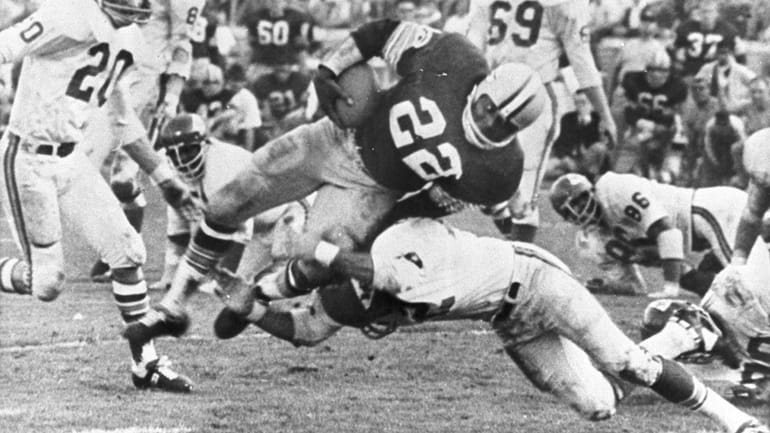Here's a Super Bowl first: A public showing of Super Bowl I at Paley Museum

Green Bay Packers' Klijah Pitts is brought down by Kansas City's Johnny Robinson in the fourth quarter of Super Bowl I in Los Angeles on Jan. 15, 1967. Credit: AP
Super Bowl history is on display in LVIII-plus ways at an exhibit at the Paley Museum called “Beyond the Big Game” that runs through March 3.
That includes all 57 Super Bowl rings, the Vince Lombardi Trophy itself and video offerings such as a showcase of 50 years of Super Bowl commercials.
But one element in particular stands out as a singularly historic moment, at least in sports media terms.
On Feb. 10 at 12:10 p.m., the museum will host the first known public screening of Super Bowl I since Jan. 15, 1967, when the Packers beat Kansas City, 35-10.
“It’s very special for us,” said Ron Simon, the head curator for The Paley Center for Media. “It’s just amazing that we have this artifact of the broadcast.”
The Paley Center has had it since 2005 and showed part of it at an anniversary fundraiser years ago. But it has not been seen in its entirety in public.
Why? It is complicated, but the video long has been part of legal and/or financial discussions among various parties, including the owner and the NFL.
That is why it will be shown once, and not for a separate admission charge but for anyone who wishes to buy a ticket for that time slot at the museum at 25 West 52nd Street in Manhattan. (Highlights from Super Bowl I will be shown Feb. 7-9.)
Tickets for early afternoon Feb. 10 still were available as of late Thursday. Doors open at 11:30 a.m. The cost is $20 for adults and free for members.
For years, Super Bowl I was among the most sought-after video in media history, feared lost even though both CBS and NBC carried the game live. The Paley Center has audio of NBC’s coverage but not video.
In 2005, the son of a Scranton, Pennsylvania, engineer who recorded most of CBS’ coverage on 2-inch videotape showed up with the precious goods.
Some of the game is missing, including part of the third quarter, but it largely has survived, a victory in itself. (Super Bowl II still is missing.)
It was common in that era to record over videotape rather than preserve shows and games. The videotape was expensive, heavy and space-consuming.
“It was the foresight of this gentleman, who worked on technology, who knew 2-inch machines, to actually make a copy of it,” Simon said. “I'm still amazed. He is one of only a handful of people that could have done this.”
The restored video is imperfect, in part because it was stored in an attic for nearly 40 years. But Simon said it offers insight into that era of television coverage.
“Whenever they do a slow-motion or video replay, they will tell the audience that they're not watching live,” he said.
The Super Bowl I screening is only one element of an extensive exhibit on which the museum worked with the NFL and Pro Football Hall of Fame.
The exhibit is only one example of a history of sports-related events and exhibits hosted by The Paley Center.
“We’ve long enjoyed close relationships with all the major sports leagues,” said CEO Maureen Reidy, who grew up in Smithtown. “Sports programming always overdelivers . . . Sports ranks among our highest priorities in terms of programming here.”
Reidy said the compilation of Super Bowl ads was a particularly good fit, given the Center’s ties to the advertising industry and its vast trove of ads from TV history.
“We thought curating a sort of never-been-done-before showcase of the most memorable Super Bowl TV commercials would be something special that people would really come out to see and experience,” she said.
“It’s very nostalgic. It takes people down memory lane.”
The Super Bowl exhibit includes game balls, helmets, jerseys, playbooks, play-call wristbands and more. Details and schedule are available at paleycenter.org.

